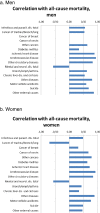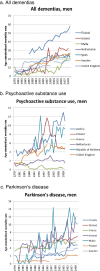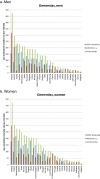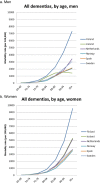The rise of mortality from mental and neurological diseases in Europe, 1979-2009: observational study
- PMID: 25118099
- PMCID: PMC4139616
- DOI: 10.1186/1471-2458-14-840
The rise of mortality from mental and neurological diseases in Europe, 1979-2009: observational study
Abstract
Background: We studied recent trends in mortality from seven mental and neurological conditions and their determinants in 41 European countries.
Methods: Age-standardized mortality rates were analysed using standard methods of descriptive epidemiology, and were related to cultural, economic and health care indicators using regression analysis.
Results: Rising mortality from mental and neurological conditions is seen in most European countries, and is mainly due to rising mortality from dementias. Mortality from psychoactive substance use and Parkinson's disease has also risen in several countries. Mortality from dementias has risen particularly strongly in Finland, Iceland, Malta, Netherlands, Spain, Sweden and the United Kingdom, and is positively associated with self-expression values, average income, health care expenditure and life expectancy, but only the first has an independent effect.
Conclusions: Although trends in mortality from dementias have probably been affected by changes in cause-of-death classification, the high level of mortality from these conditions in a number of vanguard countries suggests that it is now among the most frequent causes of death in high-income countries. Recognition of dementias as a cause of death, and/or refraining from life-saving treatment for patients with dementia, appear to be strongly dependent on cultural values.
Figures





Similar articles
-
21st century accelerating neurological deaths in UK and major Western countries: - Demographic and/or multiple-interactive-environmental causes?J Neurol Sci. 2024 Jul 15;462:123094. doi: 10.1016/j.jns.2024.123094. Epub 2024 Jun 13. J Neurol Sci. 2024. PMID: 38897154
-
[Deaths in a Tunisian psychiatric hospital: an eleven-year retrospective study].Encephale. 2014 Oct;40(5):416-22. doi: 10.1016/j.encep.2014.07.007. Epub 2014 Aug 15. Encephale. 2014. PMID: 25132014 French.
-
Cost of disorders of the brain in Europe 2010.Eur Neuropsychopharmacol. 2011 Oct;21(10):718-79. doi: 10.1016/j.euroneuro.2011.08.008. Epub 2011 Sep 15. Eur Neuropsychopharmacol. 2011. PMID: 21924589
-
The size and burden of mental disorders and other disorders of the brain in Europe 2010.Eur Neuropsychopharmacol. 2011 Sep;21(9):655-79. doi: 10.1016/j.euroneuro.2011.07.018. Eur Neuropsychopharmacol. 2011. PMID: 21896369 Review.
-
Cancer, cigarette smoking and premature death in Europe: a review including the Recommendations of European Cancer Experts Consensus Meeting, Helsinki, October 1996.Lung Cancer. 1997 May;17(1):1-60. doi: 10.1016/s0169-5002(97)00648-x. Lung Cancer. 1997. PMID: 9194026 Review.
Cited by
-
Association Between Tuberculosis and Parkinson Disease: A Nationwide, Population-Based Cohort Study.Medicine (Baltimore). 2016 Feb;95(8):e2883. doi: 10.1097/MD.0000000000002883. Medicine (Baltimore). 2016. PMID: 26937925 Free PMC article.
-
Life Expectancy and Mortality Rates in the United States, 1959-2017.JAMA. 2019 Nov 26;322(20):1996-2016. doi: 10.1001/jama.2019.16932. JAMA. 2019. PMID: 31769830 Free PMC article.
-
A Systematic Review of the Psychological Implications of Genetic Testing: A Comparative Analysis Among Cardiovascular, Neurodegenerative and Cancer Diseases.Front Genet. 2018 Dec 10;9:624. doi: 10.3389/fgene.2018.00624. eCollection 2018. Front Genet. 2018. PMID: 30619456 Free PMC article. Review.
-
Trends in Non-Hispanic White Mortality in the United States by Metropolitan-Nonmetropolitan Status and Region, 1990-2016.Popul Dev Rev. 2019 Sep;45(3):549-583. doi: 10.1111/padr.12249. Epub 2019 Jun 26. Popul Dev Rev. 2019. PMID: 31588154 Free PMC article. No abstract available.
-
Necropolitics of Death in Neurodegeneration.Cult Med Psychiatry. 2024 Jun;48(2):384-400. doi: 10.1007/s11013-024-09855-7. Epub 2024 Apr 23. Cult Med Psychiatry. 2024. PMID: 38652343 Free PMC article. Review.
References
-
- Vallin J, Mesle F. Convergences and divergences in mortality. A new approach to health transition. Demographic Res. 2004;2:11–44. doi: 10.4054/DemRes.2004.S2.2. - DOI
-
- Meslé F, Vallin J. Diverging trends in female old-age mortality: the United States and the Netherlands versus France and Japan. Popul Dev Rev. 2006;32(1):123–145. doi: 10.1111/j.1728-4457.2006.00108.x. - DOI
-
- Gruenberg EM. Epidemiology of senile dementia. Adv Neurol. 1978;19:437–457. - PubMed
-
- Kramer M. The rising pandemic of mental disorders and associated chronic diseases and disabilities. Acta Psychiatr Scand. 1980;62(Suppl. 285):282–297.
Pre-publication history
-
- The pre-publication history for this paper can be accessed here: http://www.biomedcentral.com/1471-2458/14/840/prepub
Publication types
MeSH terms
Substances
LinkOut - more resources
Full Text Sources
Other Literature Sources
Medical

